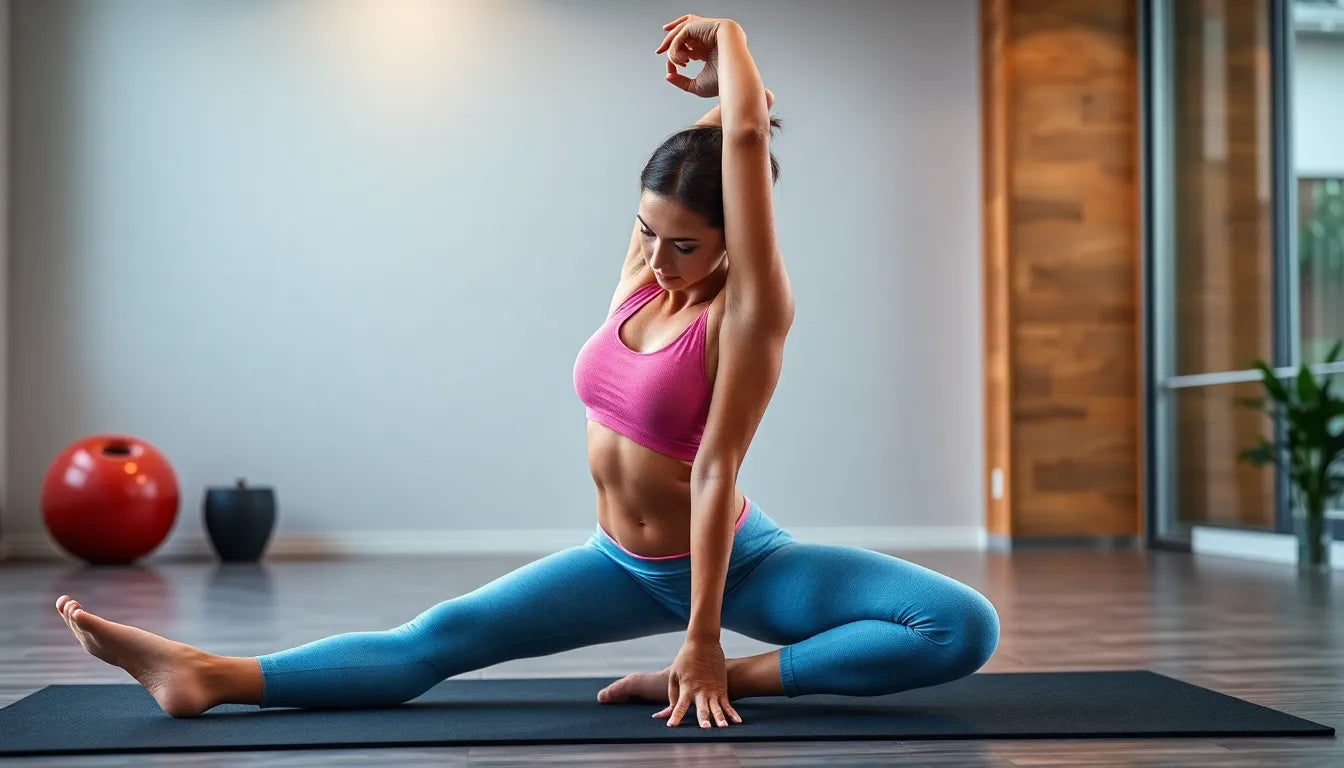Understanding the importance of biceps flexibility is crucial for anyone looking to optimize their workout regimen and overall arm health. The biceps, a prominent muscle located at the front of the upper arm, play a vital role in various arm movements, including lifting and pulling. Ensuring these muscles are flexible not only enhances performance but also significantly reduces the risk of injuries such as strains and tears.
Incorporating stretching exercises into your regular fitness routine can yield numerous benefits. By improving the range of motion, you allow your muscles to move more freely and efficiently. This increased flexibility aids in muscle recovery, enabling you to bounce back quicker after intense workouts. Moreover, regular stretching helps in reducing muscle stiffness, which is a common issue for individuals with tight biceps. This stiffness can lead to restricted arm movement and a heightened susceptibility to injuries, making flexibility training an essential component of any fitness plan.

Men's Posture Shirt™ - Black
Activates and stimulates muscles to improve posture and ease tension during daily and fitness activities.
The role of stretching in muscle health
Stretching exercises, particularly those targeting the biceps, have profound physiological effects on muscle fibers. One of the primary benefits is the increased blood flow to the muscles, which enhances nutrient delivery and waste removal. This improved circulation is vital for muscle repair and growth, making stretching a key factor in maintaining healthy muscles.
Both static and dynamic stretching exercises play a significant role in comprehensive muscle care. Static stretches involve holding a position that elongates the muscle, allowing it to relax and stretch. On the other hand, dynamic stretches incorporate movement, helping to warm up the muscles and prepare them for more strenuous activities. By integrating both types of stretches into your routine, you ensure that your muscles are both flexible and strong.
Furthermore, eccentric exercises, which focus on the lengthening phase of muscle contraction, are particularly effective in enhancing flexibility and strength simultaneously. These exercises involve controlled movements that challenge the muscle in its extended state, promoting muscle growth and flexibility. Eccentric training not only aids in muscle elongation but also strengthens the muscle fibers, making them more resilient to stress and reducing the likelihood of injury.
In conclusion, prioritizing biceps flexibility through targeted stretching exercises is essential for anyone looking to improve their arm strength and prevent injuries. By understanding the importance of flexibility and incorporating a balanced mix of static, dynamic, and eccentric exercises, you can unlock the full potential of your biceps, leading to better performance and healthier muscles.
in-depth biceps stretching exercises
To truly enhance the flexibility of your biceps, incorporating specific exercises that target both the muscle's strength and elongation is essential. These exercises not only focus on the stretching aspect but also emphasize muscle control and endurance. By practicing these targeted movements, you can effectively improve your biceps' flexibility, allowing for a greater range of motion and reducing the risk of injury.
exercise 1: preacher curl with slow eccentric phase
The preacher curl is an excellent exercise for isolating the biceps and focusing on the eccentric phase, which is crucial for muscle elongation and flexibility. This exercise helps in maximizing the muscle stretch while maintaining control, making it a staple in any biceps stretching routine.
Instructions:
- Sit at a preacher bench, ensuring your arms are fully extended over the pad while holding a dumbbell or barbell.
- Perform the curl by lifting the weight towards you in a controlled manner.
- Focus on the eccentric phase by taking 3-5 seconds to slowly lower the weight back to the starting position.
- Repeat this movement for 8-12 repetitions, concentrating on the slow descent to enhance the stretch.
exercise 2: standing biceps stretch
The standing biceps stretch is a simple yet effective static stretch designed to elongate the biceps muscles, improving their overall flexibility. This stretch is particularly beneficial for those who experience tightness in their biceps due to regular weight training or daily activities.
Instructions:
- Stand upright and extend your arms behind you, keeping your palms facing upwards.
- Place your hands against a wall or another sturdy surface for support.
- Gently rotate your torso away from the wall until you feel a stretch in your biceps.
- Hold this stretch for 15-30 seconds, ensuring you breathe deeply and relax into the position before repeating.
exercise 3: eccentric dumbbell curl
The eccentric dumbbell curl is a dynamic exercise that emphasizes the controlled lowering of the weight, promoting muscle elongation and strength. This exercise not only enhances flexibility but also builds endurance in the biceps, making it an integral part of any stretching routine.
Instructions:
- Stand with a dumbbell in each hand, allowing your arms to fully extend at your sides.
- Curl the weights upward at a normal pace, engaging your biceps throughout the movement.
- Focus on the eccentric phase by taking 3-5 seconds to slowly lower the weights back down.
- Ensure the descent is slow and controlled to maximize the stretching effect, and perform 10-15 repetitions per set.
enhancing biceps flexibility through consistent practice
Incorporating these exercises into your regular fitness routine can significantly improve your biceps' flexibility and overall arm health. By focusing on both the eccentric and static stretching phases, you ensure a comprehensive approach to muscle care. This not only aids in flexibility but also enhances muscle strength and endurance.
For optimal results, it's recommended to perform these stretching exercises 1-2 times per week, alongside your regular biceps training sessions. Adjust the training volume based on your individual goals and experience level, aiming for a total of 15-25 sets per week. By consistently practicing these exercises, you can unlock greater flexibility and performance, leading to healthier and more resilient biceps.
additional tips for effective biceps stretching
To truly unlock the full potential of your biceps, it's essential to incorporate a strategic approach to stretching that complements your overall fitness regimen. Here are some additional tips to enhance your biceps flexibility and strength:
training frequency and volume
For optimal results, perform biceps stretching exercises 1-2 times weekly. This frequency ensures that your muscles are consistently challenged and encouraged to adapt, improving flexibility over time. Additionally, maintain a general biceps training routine 2-3 times per week. Aiming for a training volume of 15-25 sets per week allows you to balance stretching with strength training, promoting muscle growth and resilience.
benefits of eccentric training
Eccentric exercises, which focus on the muscle-lengthening phase, are particularly beneficial for enhancing biceps flexibility and strength. Scientific studies have shown that regular eccentric training can lead to significant muscle growth and a reduced risk of injury. Some research indicates that strength improvements of up to 70% can be achieved over 12 weeks with consistent eccentric training. By incorporating these exercises into your routine, you not only improve flexibility but also build stronger, more injury-resistant muscles.

Women's Posture Shirt™ - Black
Supports posture and muscle activation; assists in pain relief and postural awareness for all-day use.
frequently asked questions
how often should I perform biceps stretching exercises?
Ideally, incorporate biceps stretching exercises into your routine 1-2 times per week. This frequency allows for adequate recovery while promoting flexibility and strength gains.
can stretching exercises prevent biceps injuries?
Yes, regular stretching exercises improve flexibility and can significantly reduce the risk of biceps strains and other injuries by maintaining healthy muscle function and range of motion.
what is the difference between static and dynamic stretching?
Static stretching involves holding a position to elongate the muscles, promoting relaxation and flexibility. Dynamic stretching, on the other hand, incorporates movement to warm up the muscles and prepare them for physical activity.
how do eccentric exercises benefit biceps training?
Eccentric exercises focus on the muscle-lengthening phase, enhancing both strength and flexibility. This approach not only aids in muscle growth but also reduces the likelihood of injuries by strengthening the muscle fibers.
what equipment do I need for these exercises?
Basic equipment such as dumbbells, a preacher bench, or access to a wall for stretching is sufficient for performing these biceps stretching exercises effectively.
By following these guidelines and incorporating stretching exercises into your fitness routine, you can unlock greater flexibility and performance in your workouts, leading to healthier and more resilient biceps.
Kilder
- Abild, J. (n.d.). "Arm- og albueudspænding." Jesper Abild.
- MM Sports. (n.d.). "De 7 bedste bicepsøvelser til at opbygge store arme." MM Sports Store.
- Muscle House. (n.d.). "Biceps og triceps øvelser." Muscle House.
- PureGym. (n.d.). "5 biceps øvelser du skal prøve." PureGym.
- Bodylab. (n.d.). "5 teknikker til at optimere din bicepstræning." Bodylab.
- Maxer. (n.d.). "Varier din bicepstræning." Maxer.
- Recover Gym. (n.d.). "Rehab 3: Overrivning i biceps musklen." Recover Gym.
- Styrketræningsprogram. (n.d.). "Hammer curls: En essentiel øvelse for armmuskulaturen." Styrketræningsprogram.


















